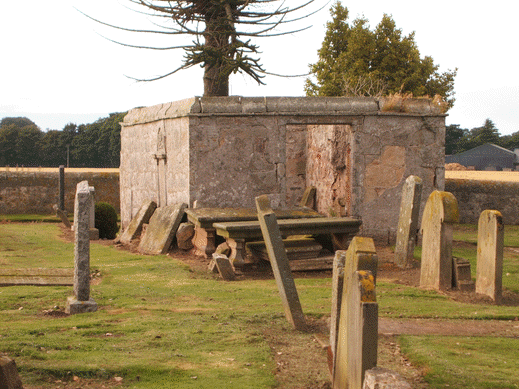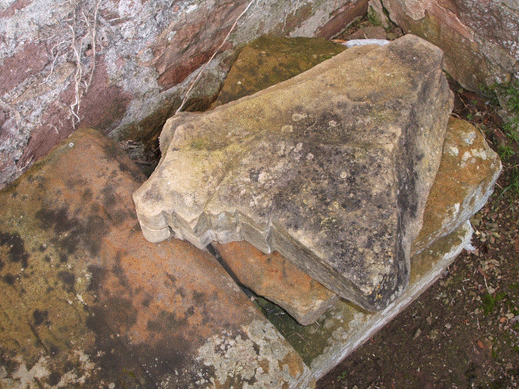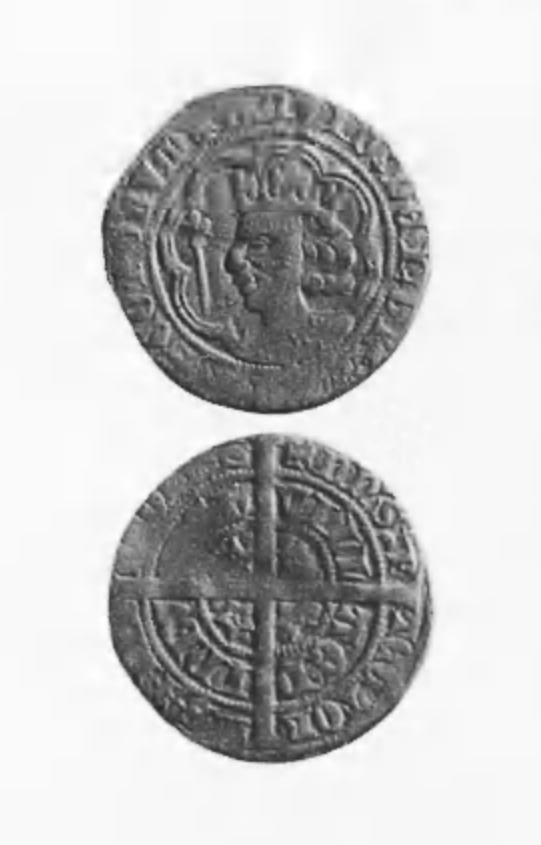Elgin Deanery
Dipple
Parish Church: OS Ref: NGR NJ 328579 H.E.S. No: NJ35NW 7 Dedication: the Holy Ghost
Associated Chapels: (none known)
The parish of Dipple - also known as Dupill, Duppol and Dupyl - is one of the lesser-known establishments of the early diocese of Moray, even though, for much of the medieval period, it formed part of a prebend of the Cathedral. Its name is said, by some, to be derived from the Gaelic diopal meaning 'the side of a hill',1 but, to even a casual observer, such a description bears little resemblance to the geography of the site, it being on the flood plain of the River Spey and only a little distance from that river's swiftly flowing waters.
The church's dedication, to the Holy Ghost, makes it almost unique since there are thought to be only two other churches in Scotland which share the same name - the Chapel of Little Gourdie near Dundee, and the Chapel of the Holy Ghost at Beauly.2 Uniquely, then, Dipple appears to have been the only parish church in Scotland to have had this dedication.


The parsonage fruits of the church of Dipple, together with that of Rothvan (Ruthven)
After the cathedral was moved to Elgin, being one of the 'senior' prebendaries, the canon of Dipple had a manse within the chanonry and, c.1223x1230, was one of those clerics provided with a croft of two acres outside the chanonry walls by Bishop Andrew.5
Many locals have lived in Moray for many years without ever becoming aware of the lovely churchyard at Dipple. Surrounded by what it is tempting to think is the original oval enclosure, it sits in a field not far from the sparkling waters of the River Spey. In time past, the Earl of Moray's valuable fishings here belonged to the Bishops of Moray.
The parishes of Dipple and Essil were united by the Commissioners of Teinds, on 14 July 1731, to form the new parish of Speymouth and the church was removed to Speymouth a year later. By 1879, only the Gordon Aisle (the old north aisle of the church?) remained. The graveyard is well kept by Moray District Council and is well worth a visit to appreciate its setting.
The wall surrounding the graveyard has been re-built on a number of occasions and, on one of these, in September 1868, a quantity of coins (10 in number) dating to the reign of David II (1329-1371) and Robert II (1371-1390), was found beneath the exposed foundations. These coins are commonly referred to as the Dipple Hoard. At least one of these coins is now to be found in the Lord Stewartby collection housed in the Hunterian Museum, Glasgow, not, as was previously thought, in the National Museums of Scotland, Edinburgh.9 Mr. Ericsson believes that the coin that he has found is the one illustrated at the foot of the BNJ article - Illus. no. 17 - an Edinburgh groat of David II.

| Name | OS Grid Ref. | Yield | Comment |
|---|---|---|---|
| Reidhall | NJ 339603 | Redhall | |
| Mosstodloch | NJ 33_60_ | ||
| Balnacoule | NJ 32_693 | ||
| Croftes | NJ 324589 | ||
| Myletoun | NJ 325595 | ||
| Dipple of Orbistounn | NJ 308572 | ½ dabhach? | Orbliston / Ormstoun |
| Gruistounn | |||
| Wastertounn | NJ 319569 | Westerton | |
| Haugh of Dippill | (between the church and the R. Spey?) | ||
| Information from Ross, A D (2003)6 with NGR numbers by David de Moravia. | |||
In the Books of Assumption, it is said that half of the lands of the parsonage of Dippill (sic.) were set to James Innes of Aichthintowill (Auchintoul), paying yearly the sum of £18 3s. 4d. It is also noted that the following deductions were due to be made from the combined annual income of Dipple and Rothvan:
- £4 to the Bishop of Moray
- £10 to the factor (for Dipple and Rothven) for his fees
- £10 to the canon's stallar for his fee
In the same source, it is most interesting to note that, "the personage of Dippill contenand the kirkis of Dippil and Ruthven in Baidyenache".7 This would appear to be a confusion since the church of Ruthven in question (i.e. Rothvan) was within the lordship of Strathbogie, not Badenoch.
(see above)
(none known.)
1187-1203 Hugh, a chaplain, parson of Duppol, signs as witness a grant of Richard, bishop of Moray, of the church of Abernethy to Patrick (Dunbar of Fogo) with its half-dabhach of land and all its other legal pertinents, in return for an annual payment of 3s. at Martinmas. [Moray Reg., no.44]
1208 One of the signatories witnessing Bishop Bricius' Magna Carta creating the cathedral establishment at Spynie, was one "Hugo, persona de Rothuan", that is, he was canon of the newly created prebend of Rothvan & Duppol. [Moray Reg., no.46]
It was at this time that Bricius created the prebend of Rothvan & Duppol and I believe that this Hugh is the same individual who witnessed the charter above, only this time being called parson of Rothuan rather than parson of Duppol.
1224-1242 Robert, canon of Duppol, is named as one of those members of the Chapter who receive a toft and croft of 2 acres from Bishop Andrew. [Moray Reg., no.96]
c.1230 Robertus, canon of Dipple, is a witness to the charter of Bishop Andrew whereby he gifts the church of Abertarff to Beauly Priory. [Chrs. Beauly, p.39]
1232 (11 October) Robertus, canon of Dipple, signs as witness a charter of Bishop Andrew whereby it is decreed that teinds which have been received from a church for the previous forty years without interruption shall not be the subject of litigation in future. [Moray Reg., no.82]
1232 Robertus, (canon) of Duppol, signs as witness a charter of Bishop Andrew whereby the bishop's lands in Dallas are exchanged for lands in Strathardle. [Moray Reg., no.79]
1237 Robertus, canon of Duppyl, signs as witness the grant, by Bishop Andrew to Walter de Moravia, of a site for a mill on the River Lossie. [Moray Reg., no.121]
1238 (5 March) R(obert), canon of Duppol, signs as witness a charter whereby the bishop and chapter agree that, in the absence of the dean, the sub-dean is to punish the vicars of the cathedral for their shortcomings and misdeeds. [Moray Reg., no.90]
1240 (4 September) Robertus, canon of Duppol, signs as witness a determination as to what should happen when one of the Chapter dies. [Moray Reg., no.92]
1430 (8 February) Thomas Archer, priest, B.Dec., Treasurer of Dunkeld and canon of Dupill, supplicates the Pope that he may be provided to the church of Mukkart, St Andrews diocese, in addition to his present benefices. [CSSR, iii, p.76]
1430 (28 February) Commissio privationis. Since a certain son of iniquity, John de Hawyc, who bears himself as rector of Kylmany, St Andrews diocese, and chaplain of the Apostolic See, at the instigation of the devil and with rash daring, laid violent hands on a certain Henry Bron, priest, vicar of said church, on a certain Sunday about the time of High Mass, when Henry was celebrating there in his vestments and priestly ornaments, thus incurring sentence of excommunication; and, moreover, setting aside the fear of God and relaxing restraints, when under sentence of excommunication he did not fear to celebrate and take part in masses and other divine offices, and often took part therein openly and publicly, whereby he has rendered himself unworthy of the said rectory and merits deprivation; therefore Thomas Archer, treasurer of Dunkeld, supplicates that Pope would give mandate to some good man in those parts that he inform himself summarily anent the foregoing, and that if he find it to be as alleged, or sufficient for the deprivation of John, he remove him from the said rectory (£46 sterling), void as above or in whatsoever way, and collate, and provide the said Thomas: notwithstanding that Thomas holds the treasurership of Dunkeld and the rectory of Mukkart, St Andrews diocese, and the canonry and prebend of Dupyll in the church of Moray (total, £60 sterling); and he is prepared to demit the rectory of Mukkart (£6 sterling).
1432 (29 April) Lately, Thomas Archier, priest, St Andrews diocese, alleged to be the son of a priest and an unmarried woman, drunk with the poison of avarice, obtained provision of the canonry and prebend and treasurership of Dunkeld, with parish church or perpetual vicarage of Mukcart, St Andrews diocese, and canonry and prebend of Dupill in church of Moray, and held them for more than two years without sufficient apostolic dispensation, on account of which these benefices are known to be void.
Gilbert Heringis, clerk, St Andrews diocese, M.A., therefore supplicates that Pope would provide him to above canonry and prebend and treasurership of church of Dunkeld (£40 sterling), void as above or howsoever: notwithstanding parish church of Ennerwick.
Item: that Pope would provide Alan de Swynton, priest, St Andrews diocese, to parish church or perpetual vicarage of Mukcart (£15 sterling), void as above.
Item: that Pope would provide Laurence de Fauside, clerk, St Andrews diocese, to canonry and prebend of Dupill, which he holds (£20 sterling): notwithstanding parish church of Kilmany. [CSSR, iii, p.221]
(I have given these last two in full in order to provide a little insight into the machinations of some of the clergy in the later medieval period.)
1437 (28 August) Alan Borcwit (Borthwick) paid the annates due for the canonry and prebend of Dupil (Dipple), in the Church of Moray, to be void by the assecution of the parish church of Kilmany, St Andrews diocese, by James Broys (Bruce). [The Apostolic Camera and Scottish Benefices, 1418–1488, Libri Annatarum, p.119]
1561 At the time of the collection of information for 'the Thirds of Benefices', Adam Hepburne was parson of Dipple.7
1. Matheson, Donald (1905) The Place Names of Elginshire, Stirling, p.191. Return
2. Mackinlay, J M (1910) Ancient Church Dedications in Scotland: scriptural dedications, p.62. Mackinlay adds that the location of the chapel of the Holy Ghost at Little Gourdie has never been found, although he describes it as having been "in the neighbourhood of Dundee."
It is, in fact, believed to have been in the vicinity of Gourdie Farm, Mains of Gourdie or Gourdie House, on the north west outskirts of Dundee
The chapel at Beauly stood attached to the north side of the Priory's nave and was also known as the Chapel of the Holy Cross. It was built by Hugh Fraser, who succeeded to the title and estates of Lovat about the year 1417. [see Batten, E C (1877) The Charters of the Priory of Beauly, London: Grampian Club, p.284-5.] Return
3. Moray Reg., no.46. Return
4. Moray Reg., no.47. Dated "at Lateran", 11 Kalends January; pontifical year 17. Return
5. Moray Reg., no.96. Return
6. Ross, A D (2003) The Province of Moray, c.1000-1230, PhD thesis presented to the University of Aberdeen. Vol.i., p.58, giving (NLS, Adv.MS.49.7.19) as his source. Ross says that these lands were in Essil parish but an inspection of the Ordnance Survey map would lead me to believe that they were, in fact, in the parish of Dipple. Return
7. Kirk, J ed. (1995) The Books of Assumption of the thirds of benefices. Oxford, p.474. Return
9. Following personal communication with Dr A. Blackwell at the National Museums of Scotland (31/1/2020) and Mr J. Ericsson at the Hunterian Museum in Glasgow (31/1/2020) it appears that one of the three coins that were not lost soon after their discovery found its way into the collection of Lord Stewartby which is now housed at the Hunterian Museum. It is possible that the other two are also in this collection, but they are yet to be located. Return
e-mail: admin@cushnieent.com
© 2019 Cushnie Enterprises
